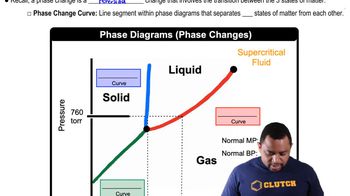Here are the essential concepts you must grasp in order to answer the question correctly.
Phase Transition
A phase transition refers to the transformation of a substance from one state of matter to another, such as solid to liquid. In the context of cholesteryl benzoate, the transition temperature indicates the specific temperature at which this change occurs. Understanding phase transitions is crucial for predicting how the addition of other compounds can affect the melting or crystallization behavior of a substance.
Recommended video:
Phase Changes in Diagrams
Molecular Shape and Packing
The shape of a molecule significantly influences its physical properties, including how molecules pack together in a solid state. Rod-like molecules, like cholesteryl benzoate, tend to pack efficiently, leading to higher transition temperatures. In contrast, curved molecules, such as cholesteryl oleyl carbonate, disrupt this packing, which can lower the transition temperature when mixed with rod-like molecules.
Recommended video:
Molecular Shapes and VSEPR
Thermodynamics of Mixing
The thermodynamics of mixing involves understanding how the interaction between different molecules affects their energy states and phase behavior. When two different compounds are mixed, the overall stability and energy of the system can change, potentially leading to an increase or decrease in the transition temperature. This concept is essential for predicting the effects of mixing cholesteryl benzoate with cholesteryl oleyl carbonate.
Recommended video:
First Law of Thermodynamics
 Verified step by step guidance
Verified step by step guidance


